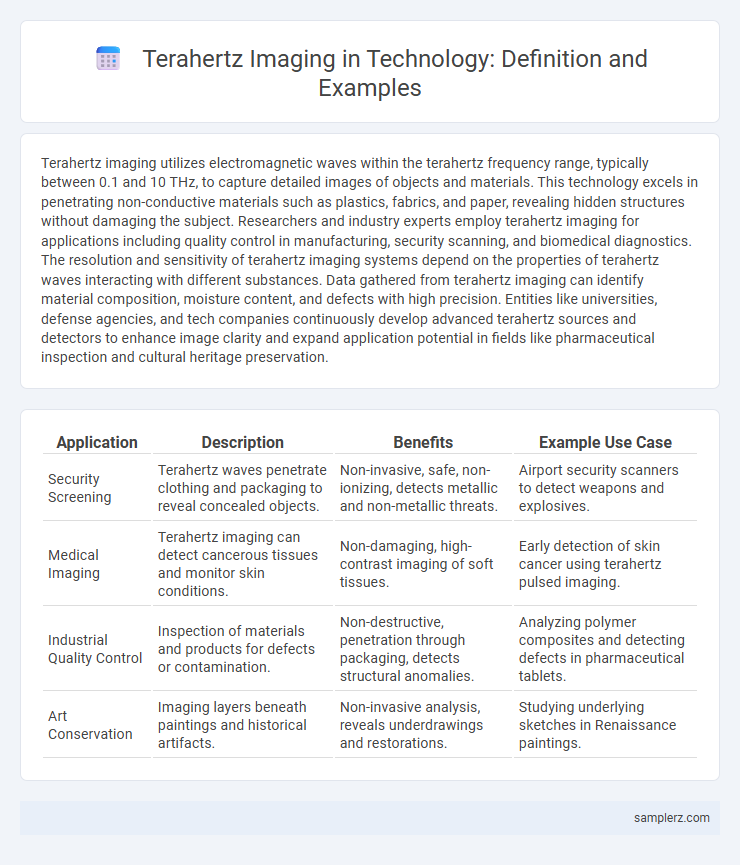Terahertz imaging utilizes electromagnetic waves within the terahertz frequency range, typically between 0.1 and 10 THz, to capture detailed images of objects and materials. This technology excels in penetrating non-conductive materials such as plastics, fabrics, and paper, revealing hidden structures without damaging the subject. Researchers and industry experts employ terahertz imaging for applications including quality control in manufacturing, security scanning, and biomedical diagnostics. The resolution and sensitivity of terahertz imaging systems depend on the properties of terahertz waves interacting with different substances. Data gathered from terahertz imaging can identify material composition, moisture content, and defects with high precision. Entities like universities, defense agencies, and tech companies continuously develop advanced terahertz sources and detectors to enhance image clarity and expand application potential in fields like pharmaceutical inspection and cultural heritage preservation.
Table of Comparison
| Application | Description | Benefits | Example Use Case |
|---|---|---|---|
| Security Screening | Terahertz waves penetrate clothing and packaging to reveal concealed objects. | Non-invasive, safe, non-ionizing, detects metallic and non-metallic threats. | Airport security scanners to detect weapons and explosives. |
| Medical Imaging | Terahertz imaging can detect cancerous tissues and monitor skin conditions. | Non-damaging, high-contrast imaging of soft tissues. | Early detection of skin cancer using terahertz pulsed imaging. |
| Industrial Quality Control | Inspection of materials and products for defects or contamination. | Non-destructive, penetration through packaging, detects structural anomalies. | Analyzing polymer composites and detecting defects in pharmaceutical tablets. |
| Art Conservation | Imaging layers beneath paintings and historical artifacts. | Non-invasive analysis, reveals underdrawings and restorations. | Studying underlying sketches in Renaissance paintings. |
Terahertz-Wave Basics in Imaging Technology
Terahertz waves, spanning frequencies from 0.1 to 10 THz, penetrate non-conductive materials, making them ideal for non-invasive imaging applications. Their ability to reveal molecular composition and structural information enables high-resolution imaging in security screening, biomedical diagnostics, and industrial quality control. Terahertz-wave technology capitalizes on unique spectral fingerprints, facilitating precise material identification and enhanced image contrast beyond traditional imaging techniques.
Medical Imaging Advances with Terahertz
Terahertz imaging technology offers non-invasive, high-resolution visualization of biological tissues, enabling earlier detection of skin cancer and dental anomalies. Its ability to differentiate between healthy and cancerous cells through unique spectral signatures significantly enhances diagnostic accuracy. Emerging applications in breast and brain imaging demonstrate terahertz waves' potential to revolutionize medical diagnostics by providing safer, radiation-free alternatives to traditional X-rays and MRIs.
Terahertz in Security Screening Systems
Terahertz imaging technology enhances security screening systems by detecting concealed weapons and explosives without physical contact or harmful radiation. Its ability to penetrate fabrics and plastics provides high-resolution, real-time images, improving threat detection accuracy at airports and public venues. Advanced terahertz scanners offer non-invasive, rapid screening, reducing false alarms and increasing passenger throughput.
Non-Destructive Testing Using Terahertz Imaging
Terahertz imaging enables non-destructive testing by penetrating materials such as plastics, ceramics, and composites without causing damage, revealing internal defects and structural inconsistencies. This technology is particularly useful in aerospace and automotive industries, where precise detection of voids, delaminations, and cracks enhances safety and reduces maintenance costs. Advanced terahertz systems provide high-resolution images that improve quality control and predictive maintenance while preserving the integrity of tested objects.
Terahertz Imaging for Pharmaceutical Quality Control
Terahertz imaging enables non-destructive analysis of pharmaceutical tablets by detecting internal defects, coating thickness, and moisture content with high precision. This technology uses terahertz waves to penetrate packaging and active pharmaceutical ingredients, ensuring consistent quality and safety in drug manufacturing. Advanced terahertz systems improve real-time monitoring and reduce reliance on traditional, time-consuming quality control methods.
Cultural Heritage and Art Analysis with Terahertz Waves
Terahertz imaging technology offers non-invasive examination of cultural heritage artifacts and artworks, revealing hidden layers, underdrawings, and structural details without physical contact. This method enables conservationists and historians to analyze the composition and condition of paintings, manuscripts, and archaeological finds with high resolution and minimal risk of damage. Terahertz waves penetrate materials like paint and ceramics, providing detailed insights that support restoration efforts and authentication processes in the preservation of cultural assets.
Terahertz Imaging in Material Defect Detection
Terahertz imaging is a cutting-edge technology used extensively for detecting material defects in industrial applications. It enables non-destructive testing by penetrating various materials like ceramics, polymers, and composites to reveal internal cracks, voids, and inclusions with high spatial resolution. This imaging method enhances quality control and reliability in manufacturing sectors such as aerospace, automotive, and electronics.
Terahertz-Based Biomedical Diagnostics
Terahertz-based biomedical diagnostics leverage terahertz waves' non-ionizing radiation to achieve high-resolution imaging of soft tissues, enabling early detection of cancerous cells and monitoring of burn wounds. This technology exploits the unique absorption spectra of biomolecules in the terahertz range, allowing precise differentiation between healthy and diseased tissues. Current advancements emphasize portable terahertz imaging systems integrated with machine learning algorithms for real-time clinical diagnostics.
Real-Time Imaging Applications with Terahertz Technology
Terahertz technology enables real-time imaging applications by penetrating materials like clothing, plastics, and ceramics, revealing concealed objects and structural defects without harmful ionizing radiation. It is extensively used in security screening, industrial quality control, and biomedical diagnostics to provide high-resolution, non-invasive visualization at high speeds. Advances in terahertz detectors and sources have significantly improved imaging frame rates, making dynamic process monitoring and live tissue imaging feasible.
Challenges and Future Prospects in Terahertz Imaging
Terahertz imaging faces challenges such as limited spatial resolution and penetration depth, which restrict its use in detailed biomedical and security applications. Advances in terahertz source technology and detector sensitivity are crucial for overcoming these limitations, enabling higher resolution and faster imaging capabilities. Future prospects include integration with artificial intelligence for enhanced image processing and the development of portable terahertz systems for real-time field diagnostics.

example of terahertz in imaging Infographic
 samplerz.com
samplerz.com